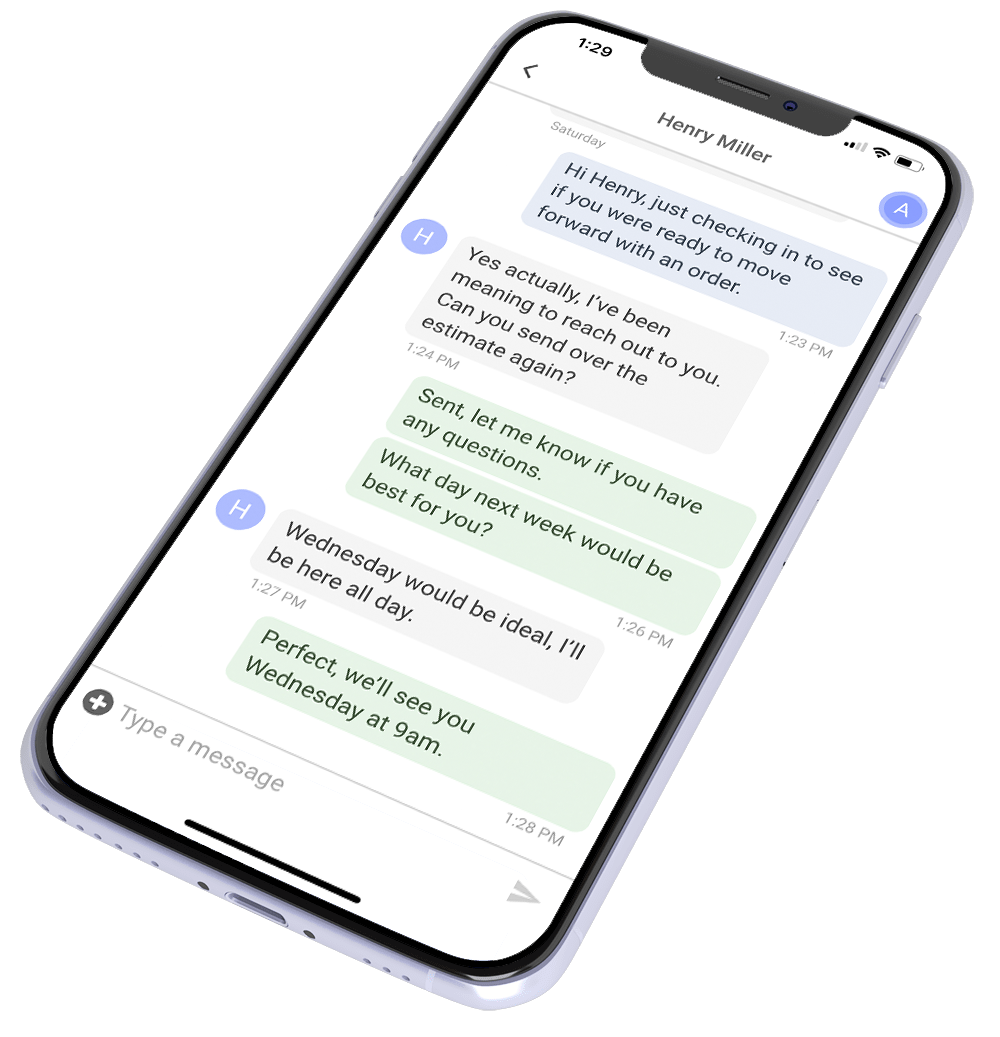Learn how communication-first roofing CRMs can boost customer trust and team efficiency for roofers in 2025.
In 2025, communication is no longer a “nice-to-have” for roofers—it’s essential. Roofing clients expect fast responses, timely updates, and easy access to information. Missed messages and delays can risk losing business, and team members need reliable ways to stay aligned on job sites and handle client requests. A communication-first roofing CRM tackles these challenges head-on, creating seamless interactions both inside and outside the business.
This guide breaks down why a communication-first CRM matters, covering core features, benefits, and the pros and cons. With tools to centralize messaging, automate updates, and keep every team member and client in the loop, this type of CRM keeps your business running smoothly. If missed calls or scattered notes are holding you back, a communication-first CRM could be the key to building better client connections and keeping your business on track.

What Is a Communication-First CRM?
In a business where communication makes all the difference, a communication-first CRM ensures every message, update, and schedule stays organized and accessible. Unlike CRMs focused mainly on data or lead tracking, this type of CRM centers on real-time, back-and-forth communication with customers and keeps your team aligned at every stage of a job. It’s designed to handle messaging, automate updates, and maintain seamless coordination between customers and team members, reducing delays and missed connections.
A communication-first CRM doesn’t just store data; it actively manages interactions. Customers receive timely updates, while team members can view schedules, tasks, and notes in real-time. Features like automated messaging, customer portals, and task coordination keep everyone on the same page, preventing confusion and delays. This approach keeps customers informed, aligns the office and field teams, and ensures that projects run smoothly from start to finish.
Communication-first CRMs are extremely rare, especially for roofers. Why? Because communication often comes second to project management for many roofers. It makes sense. Roofers tend to be a pragmatic group. Project management feels more useful and practical. Until, of course, they have dozens of unhappy Google reviews and ghosted homeowners knocking down their doors.
Key Features of a Communication-First CRM for Roofers
A communication-first CRM doesn’t just store details—it actively manages every interaction and update, from team coordination to client follow-ups. This type of CRM keeps everyone on the same page and makes communication seamless.
One central feature is a unified messaging platform that combines in-app messaging, email, and SMS. With all messages in one place, your team can communicate easily with each other and clients, whether it’s a quick text update or a detailed email. This centralized approach prevents missed messages and cuts down on time spent switching between apps.
Automation is another key element, especially for customer updates. With automated reminders and status notifications, clients stay informed without anyone on your team needing to step in manually. Whether it’s a reminder for an upcoming appointment or a post-job follow-up, these timely updates build trust and reduce unnecessary calls.
The CRM also organizes jobs into detailed stages, visible on a single dashboard. As tasks progress, the CRM automatically moves projects forward and triggers actions, keeping everything on track without manual handling. Task and appointment scheduling further supports efficiency, reducing missed appointments and double-bookings with timely notifications.
Document sharing and e-signatures speed up approvals and paperwork. Clients can view, sign, and return contracts online, cutting down on delays and reducing the need for in-person meetings. Each approved document is saved in the CRM, ensuring all records are secure and easily accessible for the next step in the project.
Pros and Cons of Using a Communication-First CRM
A communication-first CRM can transform business operations, but it’s not without trade-offs. Understanding the pros and cons can help you decide if it’s the right fit for your team.
On the positive side, a communication-first CRM improves customer satisfaction by delivering fast, clear updates that build trust. Clients feel involved and informed, which strengthens relationships and encourages referrals—happy customers bring in new business. Internally, this CRM streamlines coordination, reducing miscommunication and preventing errors or overlapping schedules. When all team members—from the office to the field—have real-time access to updates, jobs run more smoothly with fewer surprises.
Speed also matters when responding to leads, and a communication-first CRM ensures quick follow-ups through automated responses and instant notifications, helping you capture more opportunities. Additionally, by handling reminders, follow-ups, and routine updates, a CRM significantly reduces admin work, freeing your team to focus on projects and growth rather than paperwork.
However, there are some drawbacks. Setting up a new CRM requires time and training, which can be a big investment for smaller teams. Some providers, like ProLine, offer free onboarding and support, easing the transition and minimizing disruption. Another potential downside is notification overload—too many alerts can lead to “message fatigue.” You’d be surprised how rare message fatigue actually is. Customizable settings, though, allow you to strike a balance, keeping everyone informed without overwhelming inboxes.
Signs Your Roofing Business Needs a Communication-First CRM
For many roofing businesses, a communication-first CRM isn’t just helpful—it’s critical. Are you fielding frequent customer complaints about being left in the dark? Each “what’s going on?” call isn’t just a question; it’s a sign of slipping trust. Clients want to know their project is progressing smoothly, and when they don’t hear from you, they may start looking elsewhere. A communication-first CRM automates updates at every job stage, so clients stay informed without having to ask, boosting their confidence in your business.
If your team regularly misses key details—whether in sales, the office, or the field—it’s a clear sign that communication is breaking down. Missed details lead to errors, delays, and costly rework, all of which drain resources and wear down your team. A CRM centralizes every message, job update, and appointment in one place, so your team can work with precision instead of playing catch-up.
Struggling with missed appointments and inconsistent follow-ups? Every no-show or forgotten callback is a lost opportunity and a potential ding to your reputation. A CRM automates reminders, ensuring that appointments run smoothly and follow-ups happen on time. As your customer base grows, the challenge of managing communication multiplies. A CRM scales with you, handling multiple clients, messages, and appointments seamlessly.
And if keeping track of client preferences and feedback feels like an impossible task, a CRM could be the missing piece. Each customer interaction is logged and accessible, enabling personalized follow-ups that make clients feel valued. If any of these problems are holding back your business, it’s time to consider a communication-first CRM—before small issues turn into lost revenue and lost clients.
How to Implement a Communication-First CRM Smoothly
Rolling out a communication-first CRM requires some planning, but with the right approach—and the right support—the transition can be seamless. Start by preparing your team: explain how the CRM will help them and gather input on any pain points they face. Understanding these challenges lets you tailor the setup to meet their needs, reducing resistance and building support for the new tool.
Set up communication templates for key tasks like job updates, appointment reminders, and follow-ups. Customizing these templates ensures clear, consistent communication at every stage, while automations allow the CRM to handle routine messages, freeing up your team’s time. Effective training is crucial, so hold hands-on sessions where your team can see how the CRM simplifies their daily work, leading to fewer mistakes and stronger buy-in.
Once the CRM is live, gather feedback from your team—and even clients. Use this feedback to adjust settings, improve timing, and refine templates for maximum clarity and effectiveness. Regular fine-tuning keeps the CRM aligned with your needs, ensuring it becomes a valuable asset that grows with your business. With ProLine’s ongoing support, you’re equipped to make the most of this powerful tool from day one.
ProLine offers two dedicated onboarding calls, where their experts walk you through the initial setup, answer questions, and guide you on optimizing ProLine for your business. These sessions set your team up for success, giving them a chance to learn the system’s features with professional guidance. Plus, ProLine’s unlimited support calls mean you’re never left troubleshooting on your own—help is always just a call away.
Conclusion: Embracing a Communication-First CRM for Roofing Success
If missed updates, delayed responses, or team miscommunication are holding back your business, a communication-first CRM could be the key to moving forward. Start by assessing your needs, involve your team in the setup, and choose a CRM that keeps communication front and center. With thoughtful implementation—setting up templates, training your crew, and gathering regular feedback—you’ll get the most from the system.
Imagine your roofing business running like a well-tuned machine, where every team member, from sales to field staff, has instant access to the information they need. Jobs flow seamlessly, customers receive timely updates, and your reputation for reliability grows with each project. By harnessing the power of a communication-first CRM, you’re not just streamlining operations—you’re setting a new standard for customer service in roofing. Dive in and see how a connected, communication-driven approach can position your business as the go-to choice in a competitive market.
Want to learn more about ProLine? Watch our overview video to see how it simplifies roofing CRM needs.
Ready to see ProLine in action? Book a demo to explore how it can work for your team.
Curious about other top CRM options? Check out our guide to the 8 best roofing CRMs and find the best fit for your business.



